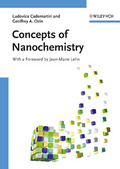Concepts of Nanochemistry

1. Edition August 2009
XX, 262 Pages, Softcover
50 Pictures (50 Colored Figures)
Textbook
Short Description
Authored by one of the pioneers and a rising star in the field, this textbook bridges chemistry, materials science and physics. It is written in a conversational manner with many examples, making it enjoyable to read and for browsing through topics.
Authored by a rising star in the field and one of its pioneers, this textbook is ideal for interdisciplinary courses - bridging chemistry, materials science, physics and biology. Adopting a completely new and visionary approach, this is a unique learning tool, focusing on just six concepts crucial for understanding nanochemistry: surface, size, shape, self-assembly, defects and the interface of biology and nanochemistry.
These concepts are elucidated through the analysis of six materials representing the real life application of the nanochemistry concepts. The teaching questions included provide real "food for thought", thus training students to think as a researcher does and so develop problemsolving skills.
Nanochemistry - Why Should We Care?
What is Nanochemistry?
This Book - Instructions for Use
AN INTRODUCTION TO NANOCHEMISTRY CONCEPTS
Nanochemistry - What's in a Name?
On the Surface of Things
Size is Everything...Almost
Shape
Self-Assembly
Two Words About Defects
The Bio-Nano Interface
Safety
SILICA
Introduction
Surface
Size
Shape
Self-Assembly
Defects
BioNano
Conclusion
Silica - NanoFood for Thought
GOLD
Introduction
Surface
Size
Shape
Self-Assembly
Defects
BioNano
Gold - NanoFood for Thought
POLYDIMETHYLSILOXANE
Introduction
Surface
Size
Shape
Self-Assembly
Defects
BioNano
PDMS - NanoFood for Thought
CADMIUM SELENIDE
Introduction
Surface
Size
Shape
Self-Assembly
Defects
BioNano
CdSe - NanoFood for Thought
IRON OXIDE
Introduction
Surface
Size
Shape
Self-Assembly
Defects
BioNano
Iron Oxide - NanoFood for Thought
CARBON
Introduction
Surface
Size
Shape
Self-Assembly
Defects
BioNano
Conclusion
Carbon - NanoFood for Thought
NANOCHEMISTRY CASE HISTORIES
Introduction
Case #1
Case #2
Conclusions
NANOCHEMISTRY DIAGNOSTICS
A Reference Sheet
Microscopy Techniques
Diffraction Techniques
Spectroscopic Techniques
Magnetic Techniques
Separation Techniques
Thermal Techniques
Adsorption Techniques
Electrical Techniques
CHALLENGES IN NANOCHEMISTRY
Prize in Chemistry, the Canadian Society of Chemistry Prize for Graduate Work in Inorganic Chemistry, the American Chemical Society DIC Young Investigator Award and the Governor General Gold Medal, a prize conferred annually to the three most academically accomplished graduate students of the University of Toronto. He is author of 16 publications in international journals, he gave numerous invited lectures and he is coauthor of two textbooks on nanochemistry.
Geoffrey A. Ozin studied chemistry at Kings College University of London and Oriel College University of Oxford. He is Government of Canada Research Chair in Materials Chemistry and Distinguished University Professor at the University of Toronto, Canada. He has made exceptionally important contributions to the fields of self-assembly, materials chemistry, biomimetics, photonic crystals, nanochemistry and nanomotors. The significance of his research has recently been recognized by Canada`s CIC SCI LeSueur Memorial Award, NSERC Inaugural Brockhouse Interdisciplinary Prize 2005, E.W.R. Steacie CSC Award 2002 and CIC Medal 2001, Germany`s Alexander von Humboldt Award 2005, and Britain`s RSC Materials Chemistry Award 2002. He serves on the editorial advisory board of journals such as Advanced Materials and Journal of Materials Chemistry and is an experienced book author. He has published 600 articles and obtained 10 US patents. His close ties with industry have resulted in numerous inventions and technology transfer. He is co-founder of Opalux, a Toronto company commercializing photonic crystal products that have emerged from his research. The ISI citation impact of his papers place his research in the top 100 and he is an ISI Top-Ten Materials Scientist 1996-2006.


